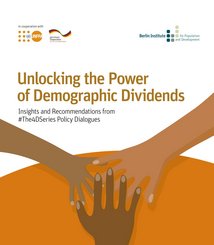
This report highlights the potential of targeted population policies to achieve demographic dividends.
Read more
Population growth rates in Africa are the highest in the world. By mid-century, there could be 2.5 billion people living on the continent – almost twice as many as today. This is mainly a result of high fertility rates, making it increasingly difficult to provide hospitals, schools, housing and, above all, jobs for future generations.
High fertility rates also prevent a shift in the age structure that could boost growth, as experienced by Asian tiger countries. Fertility rates on the African continent need to fall rapidly for socio-economic development and to reap a “demographic dividend”. A number of regional trailblazers have shown that careful demographic policy can make this possible. The study highlights interventions that can contribute to declining fertility rates and discusses what other African countries can learn from the experiences of these pioneers.
The Berlin Institute would like to thank the Federal Foreign Office for funding the project. The Berlin Institute is solely responsible for the content of the study.
Student Assistant
Telefon: +49 30 - 22 32 48 45
Contact via Mail: engler@berlin-institut.org
© Berlin-Institut
Executive Director
Telefon: +49 30 - 22 32 48 45
Contact via Mail: hinz@berlin-institut.org
© Berlin-Institut
© Berlin-Institut
Demographic change is not a disaster, but a challenge. Analyses and concepts are needed to master them successfully. The Berlin Institute for Population and Development provides these free of charge and makes a significant contribution to ensuring that important future issues are discussed on a broad basis and put on the political agenda. The non-profit Berlin Institute works on a non-partisan basis and receives no state funding whatsoever. Your donation therefore helps to maintain our independence and the high standard of our publications. Donations to the Berlin Institute are tax-deductible and can be made directly online using the donation button or by using a bank transfer form to the following account
Donation account
GLS Bank
IBAN DE15 4306 0967 1276 4833 00
BIC/SWIFT GENODEM1GLS
We thank you very much for your support!